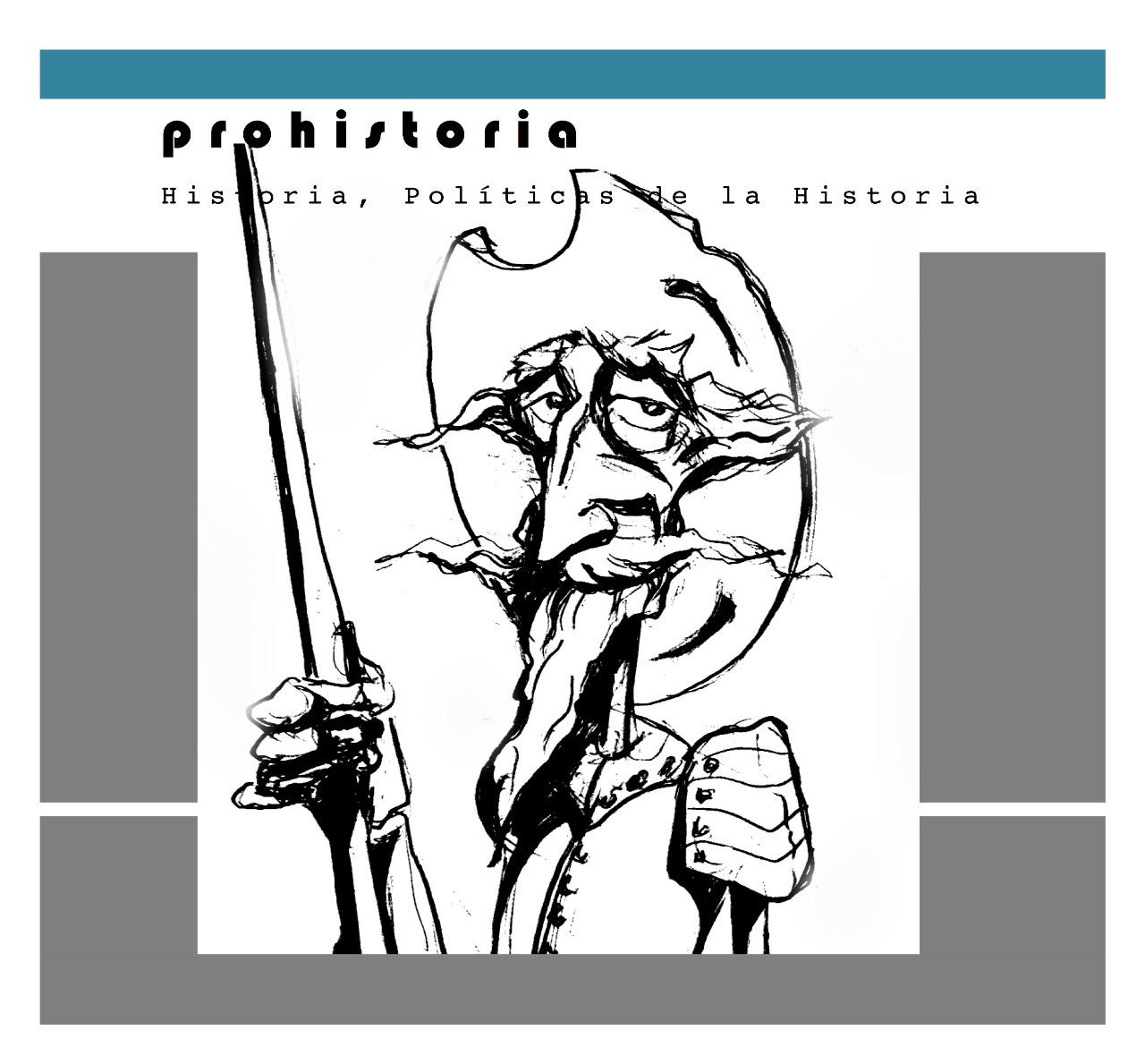Tomiris and the blood: Narratives on ancient women in the Spanish military treatises of the Renaissance
DOI:
https://doi.org/10.35305/prohistoria.vi41.1869Keywords:
Women, Treaties, Military, Antiquity, RenaissanceAbstract
We explore the narratives adopted by sixteenth-century authors on women from the Ancient World in various Spanish military treatises. It is of particular interest to observe which female characters and/or stories are mentioned, in what context, and their function in the construction of the military-theoretical discourses of the Renaissance. Thus, it is of paramount importance to analyse how these women and their attributes (physical, moral) are described and how they relate to the authors' female contemporaries and the duties of members of the military, in order to connect with the ideal of the perfect Christian soldier of the sixteenth century. We consider that these narratives on ancient women, intimately connected to the impact of the Latin classics on 16th century military treatises, will have a great relevance in the perception and generation of discourses on fundamental theoretical and practical aspects of military life: from the soldier's chastity, to violence against women or their presence as companions of the troops.
Downloads
References
Atienza, B. (2009). El loco en el espejo: locura y melancolía en la España de Lope de Vega. Rodopi.
Barrientos Grandon, J. (s/f). Juan López de Vivero. En DB-e. Real Academia de la Historia. URL: https://dbe.rah.es/biografias/12315/juan-lopez-de-vivero [Recuperado 22/08/2023].
Baskin, J. (2022). Jewish Traditions About Women and Gender Roles: From Rabbinic Teachings to Medieval Practice. En D.M. González Doreste y F. Plaza Picón (Eds.), Estereotipos femeninos desde la antigüedad clásica hasta el siglo XVI. De Gruyter.
Benson, P. (1992). The Invention of Renaissance Women: The Challenge of Female Independence in the Literature and Thought of Italy and England. Pennsylvania State University Press.
Bowd, S. (2018). Renaissance and Mass Murder. Civilians and soldiers during the Italian Wars. Oxford University Press.
Calderón Felices, J. (2018). Notas sobre la tradición de la Historia Augusta en la historiografía y literatura españolas. Anuari de Filologia. Antiqva et mediaevalia, 8, 169-181.
Callejón Peláez, A. (2006). Los ciclos iconográficos del monasterio de San Jerónimo de Granada. Tesis de doctorado, Universidad de Granada.
Casado Soto, J. L. (1995). Discursos de Bernardino de Escalante al Rey y sus Ministros (1585-1605). Universidad de Cantabria.
Cátedra, P. y Rojo, A. (2004). Bibliotecas y lecturas de mujeres. Siglo XVI. Instituto de Historia del Libro y de la Lectura.
Charrier-Vozel, M. et al. (Eds.) (2023). Femmes de guerre à l’epoque moderne (domaine français, miroirs étrangers). Jouer avec les representations. Atrois Presses Université.
Egea Vivancos, A. (1998). La continencia de Escipión. Panta Rei, 4, 1-9.
Elliot, D. (2013). Gender and The Christian Traditions. En J. Bennet y R. Karras (Ed.), The Oxford Handbook of Women and Gender in Medieval Europe (pp. 21-35). Oxford University Press.
Escalante Arce, P. (s/f). Diego García de Palacio. En DB-e. Real Academia de la Historia. URL https://dbe.rah.es/biografias/16273/diego-garcia-de-palacio [Recuperado 23/08/2023].
Espino López, A. (2000). El aprendizaje de la guerra a través de las obras de los historiadores de la Antigüedad. Obradoiro de Historia Moderna, 9, 189-210.
Espino López, A. (2001). Guerra y Cultura en la Época Moderna. Ministerio de Defensa.
Ezquerra Revilla, I. (s/f). Fortún García de Ercilla Arteaga. En DB-e. Real Academia de la Historia. URL https://dbe.rah.es/biografias/6748/fortun-garcia-de-ercilla-arteaga [Recuperado 22/08/2023].
Federici, M. (2020). Teoría y práctica de la guerra: Francisco de Pedrosa y un episodio sobre la toma de África. Studia Aurea, 34, 395-420.
Filosa, E. (2004). Boccaccio e le “milieres clarae”: dalla “Familiare” 21:8 al “De mulieribus claris. Annali d’Italinistica, 22, 381-395.
Gallardo, B. J. (1866). Ensayo de una biblioteca española de libros raros y curiosos. Vol. 2. Rivadeneyra.
García Hernán, E. (2004) Don Sancho de Londoño. Perfil biográfico. Revista de Historia Moderna, 22, 7-72.
García Tapia, N. (s/f). Diego de Álava y Viamont. En DB-e. Real Academia de la Historia. URL https://dbe.rah.es/biografias/8011/diego-de-alava-y-viamont [Recuperado 22/08/2023].
Gelabert, J. (2014). Los avisos de Luis Valle de la Cerda en contexto (1598-1599). Obradoiro de Historia Moderna, 23, 35-69.
González Castrillo, E. (1996). El arte militar en la España del siglo XVI: estudio histórico-bibliográfico. Tesis de doctorado, Universidad Complutense de Madrid.
González Criado, E. (2016). La literatura como recurso formativo del príncipe: evolución a lo largo de la Baja Edad Media. Educatio Siglo XXI, 34 (3), 65-80.
Herrán Alonso, E. (2005). “La vida del hombre es una cavalleria sobre la tierra” Sobre el Libro de la Cavalleria cristiana de Fray Jaime de Alcalá, en J. Matas Caballero y J. M. Trabado Cabado (Coords.), La maravilla escrita, Antonio de Torquemada y el Siglo de Oro (pp. 424-438). Universidad de León.
Jiménez Belmonte, J. (2011). Historiar el Oriente: Cleopatra en la historiografía española del XVI. eHumanista, 17, 286-310.
Jiménez Belmonte, J. (2018). Estetizar el exceso. Cleopatra en la cultura hispánica medieval y del Siglo de Oro. Tamesis.
Lavenia, V. (2015). Il Catechismo dei soldati: Guerra e cura d’anime in età moderna. Edizioni Dehoniane Bologna.
Lavenia, V. (2018). Dio in unirforme (Cappelani, catechesi cattolica e soldati in età moderna). Il Mulino.
López Cordón, M. V. (1994). La conceptualización de las mujeres en el Antiguo Régimen: los arquetipos sexistas. Manuscrits, 12, 79-107.
López de Coca Castañer, J. E. (s/f). Hernán Pérez del Pulgar. En DB-e. Real Academia de la Historia. URL https://dbe.rah.es/biografias/5473/hernan-perez-del-pulgar [Recuperado 22/08/2023].
Lynn, J. (2008). Women, Armies, and Warfare in Early Modern Europe. Cambridge University Press.
Lynn, J. (2012). Essential Women, Necessary Wives, and Exemplary Soldiers: The Military Reality and Cultural Representation of Women’s Military Participation (1600-1815). En B. Hacker y M. Vining (Ed.), A Companion to Women’s Military History (pp. 93-136). Brill.
Maclean, I. (1980). The Renaissance Notion of Woman. A study in the fortunes of scholasticism and medical science in European intellectual life. University of Cambridge.
Martínez Bermejo, S. (2014). Antigua disciplina: el ejemplo romano en los tratados militares ibéricos, c. 1560-1600. Hispania, 73 (247), 357-384.
Martínez Góngora, M. (2007). El hombre atemperado. Autocontrol, disciplina y masculinidad en textos españoles de la temprana modernidad. Peter Lang.
McKendrick, M. (2010). Woman and Society in the Spanish Drama of the Golden Age: A Study of the Mujer Varonil. University of Cambridge.
Millán González, S. (2017). Reinos de amazonas en la literatura española de la Edad Media y los Siglos de Oro: arquetipos, género y alteridad. Tesis de doctorado, Universitat de València.
Milligan, G. (2018). Moral Combat. Women, Gender, and War in Italian Renaissance Literature. University of Toronto Press.
Nájera, L. (2015). The Deployment of the Classics in Early Modern Spanish Military Manuals. Sixteenth Century Journal, 46 (3), 607-627.
Otero D’Costa, E. (1952). Biográfica disertación sobre el capitán don Bernardo de Vargas Machuca. Revista de Indias, 12, 49-79.
Parker, G. (2013). The Military Revolution. Military innovation and the rise of the West 1500-1800. Cambridge University Press.
Perry, M. E. (1990). Gender and Disorder in Early Modern Seville. Princeton University Press.
Romero Tabares, M. I. (1998). La mujer casada y la amazona. Un modelo femenino renacentista en la obra de Pedro de Luján. Universidad de Sevilla.
Sanz Julián, M. (2012). De claris mulieribus de Boccaccio: de la edición de Ulm (1473) a la de Zaragoza (1494). En N. Fernández Rodríguez y M. Fernández Ferreiro (Eds.), Literatura medieval y renacentista en España. Líneas y pautas (pp. 897-907). La Semyr.
Suárez, S. (2024). Prostitution and the Control of Sexuality in the 16th Century Spanish Army. War & Society. In press.
Taylor, F. (2012). The Art of War in Italy 1494-1529. Cambridge University Press.
Tinagli, P. (1997). Women in Italian Renaissance Art: Gender, Representation and Identity. Manchester University Press.
Torres Corominas, E. (s/f). Cristóbal Mosquera de Figueroa. En DB-e. Real Academia de la Historia. URL https://dbe.rah.es/biografias/74259/cristobal-mosquera-de-figueroa [Recuperado 25/08/2023].
Vargas Martínez, A. (2016). La Querella de las Mujeres. Tratados hispánicos en defensa de las mujeres (siglo XV). Fundamentos.
Wiesner-Hanks, M. (2000). Women and Gender in Early Modern Europe. Cambridge University Press.
Published
How to Cite
Issue
Section
License
Copyright (c) 2024 Sandra Suárez García

This work is licensed under a Creative Commons Attribution-NonCommercial-ShareAlike 4.0 International License.
- Authors retain copyright and grant the journal right of first publication with the work simultaneously licensed under Creative Commons Attribution 4.0 International License.
- Authors are able to enter into separate, additional contractual arrangements for the non-exclusive distribution of the journal's published version of the work (e.g., post it to an institutional repository or publish it in a book), with an acknowledgement of its initial publication in this journal.
Copyright of this issue © Prohistoria. Historia, políticas de la historia



















